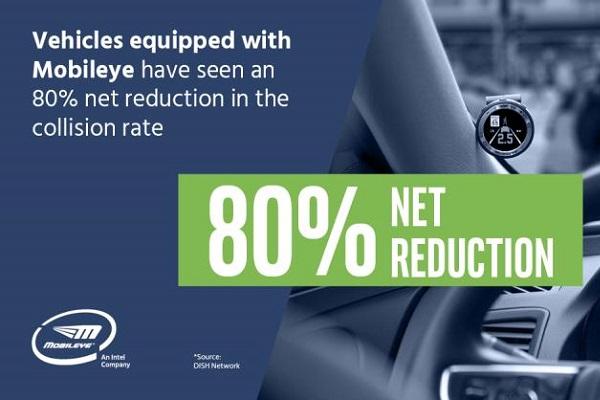ADAS.ie partners with Mobileye in providing collision avoidance systems as a retrofit for vehicles in Ireland. Our partner recently produced a case study based on their work with a company in the US, which demonstrates benefits which go beyond saving lives.
When DISH Network Corporation USA adopted the Mobileye collision avoidance system for its fleet in 2016, they looked forward to improving driver safety, decreasing vehicle downtime and lowering their exposure to liability claims. What they didn’t expect was an increase in fuel savings – reporting at least a 2% increase.
And with fuel making up 21% of the average fleet’s marginal cost, these savings are significant. But how exactly does retrofitting your fleet with a collision avoidance system save fuel?
A major component of Mobileye’s collision avoidance system is the headway monitoring warning (HMW). The collision avoidance system constantly scans the road ahead, monitoring the distance, in seconds, between vehicles. When this distance become unsafe, the HMW warns the driver.
Crucially, this alert activates before the driver is in danger, allowing them to take preventative action before the situation becomes critical forcing the driver to take emergency action. For example, if a distracted driver gets too close to the vehicle ahead, they receive a warning that allows them to slow down as opposed to slamming on the brakes. And, of course, almost every incident of harsh braking is accompanied by an incident of rapid acceleration, two main culprits in added fuel consumption.
In fact, according to the US Department of Environmental Protection Energy, aggressive driving – a category which includes, speeding, harsh braking and rapid acceleration – can decrease gas mileage by up to 40% in stop-and-go traffic. Gamma Technologies ran a study comparing two simulations – in one, a vehicle closely followed a lead vehicle while in the second a vehicle followed the lead vehicle at a safe distance. Engineers were surprised to find a 3% drop in fuel consumption simply by following at a safe distance.
A further benefit of HMW is that as drivers gain experience using the technology, they actually improve their driving habits, anticipating the alerts and acting to prevent them. This means even fewer incidents of harsh braking, increasing fuel efficiency even more.
Of course, these savings come on top of the other, myriad, benefits of collision avoidance systems—increased uptime for your fleet, decreased liability and, most importantly, keeping your drivers safe. Vehicles equipped with Mobileye have seen a net 80% reduction in the collision rate.
Taken from a recent Mobileye article.

